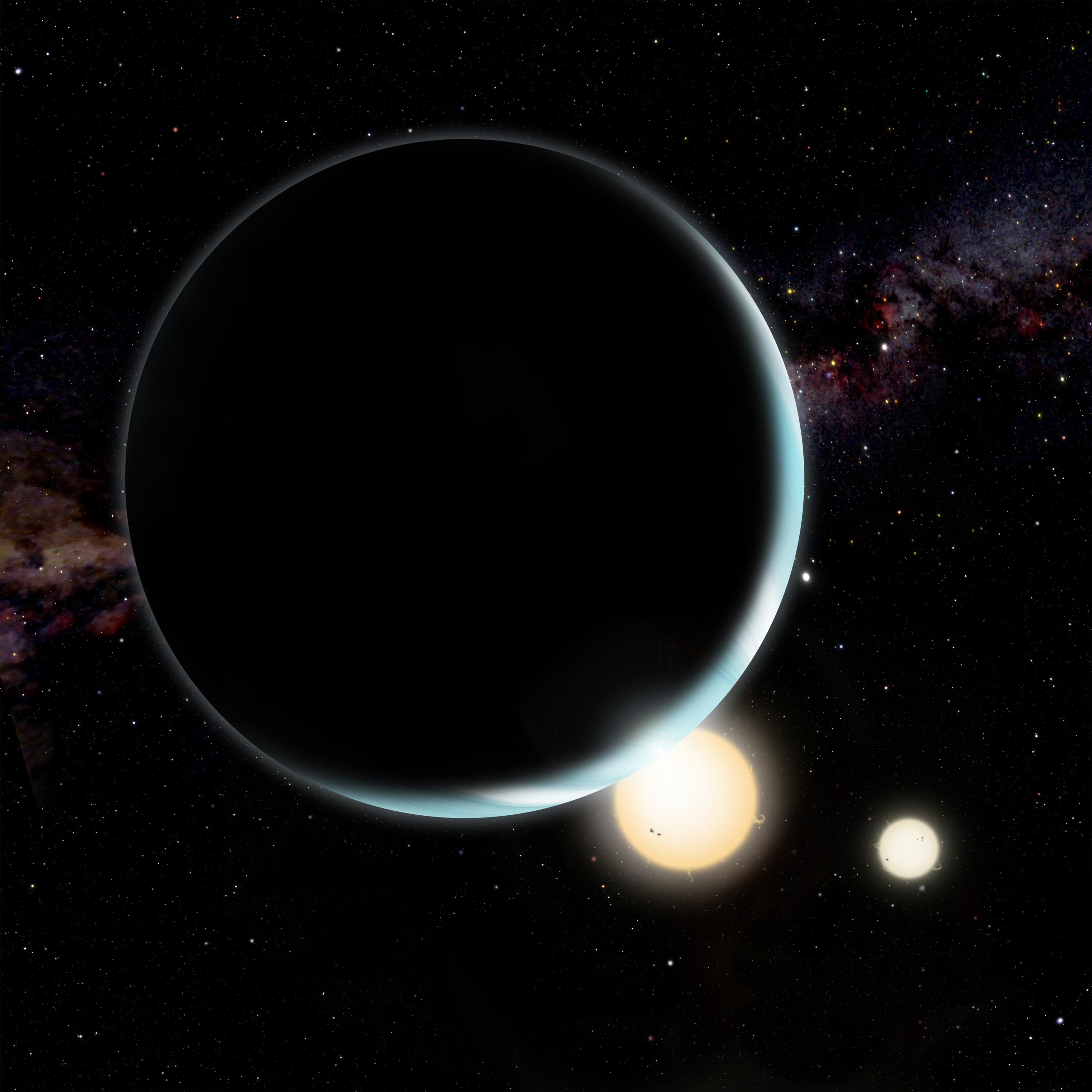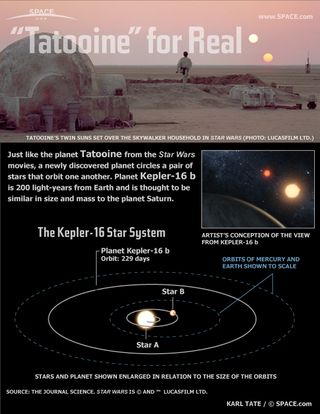'Tatooine' Alien Planets May Form Far from Twin Suns

Worlds with twin suns like Luke Skywalker's fictional home world Tatooine in "Star Wars" may be born far from the stellar heart of their alien solar systems, scientists say.
Although Earth may orbit around a single star, most sun-like stars are binaries — two stars orbiting each other as a pair. In fact, there are many three-star systems, even going up as high as seven-star systems.
Worlds that orbit around binary stars are known as circumbinary planets. The first real-life alien planet with two suns ever discovered by astronomers is Kepler-16b, a gas giant found orbiting the star Kepler-16 about 200 light-years from Earth. [NASA Discovers 1st Real-Life 'Tatooine' Planet (Gallery)]
Planets are born from protoplanetary disks of gas and dust that orbit stars. Scientists had thought the very strong gravitational pull binary stars would exert on these disks might disturb the material within too much for it to easily coalesce into worlds. This made the existence of circumbinary planets in real life a bit of a mystery.

How 'Tatooine' alien planets are born
To learn more about how circumbinary worlds form, researchers analyzed the twin-sun planet Kepler-34(AB)b, which is located about 4,900 light-years from Earth. This world, also known as Kepler-34b, is about 22 percent of the mass of Jupiter (the largest gas giant in our solar system) and 76 percent the width of Jupiter. It orbits its two sunlike stars at about the same distance as Earth is from the sun, and was discovered used NASA's Kepler space telescope.
The scientists performed high-resolution, 3D computer simulations of the early stages of planet formation around binary stars. These used an intricate model that calculated the effect of gravity and physical collisions on and between one million planetary building blocks, each 60 miles (100 kilometers) wide.
Get the Space.com Newsletter
Breaking space news, the latest updates on rocket launches, skywatching events and more!
The researchers discovered the majority of the simulated exoplanets that resulted originated far from their binary stars.
"Taking into account data on collisions as well as the physical growth rate of planets, we found that Kepler 34(AB)b would have struggled to grow where we find it now," study author Zoe Leinhardt, an astrophysicist at the University of Bristol in England, said in a statement.
In the area close to binary stars, the planetary building blocks experienced what the researchers called "super-catastrophic erosion events," breaking up into smaller chunks instead of merging into planetary embryos. This made circumbinary planets in the inner parts of binary systems unlikely, they said.

The researchers suggest that Kepler 34(AB)b, like many other known circumbinary planets, may have migrated inward from where they originally formed to where astronomers see them now. A minimum safe distance for Kepler 34(AB)b's formation would be about 1.5 astronomical units (AU). (One AU is the average distance between Earth and the sun.)
"Our results seem to indicate that all inner circumbinary planets have migrated," Leinhardt told Space.com.
One possible exception may be the circumbinary planet Kepler-47c, which is further away from its stars than any other known circumbinary planet.
"Circumbinary planets have captured the imagination of many science-fiction writers and filmmakers," study lead author Stefan Lines at the University of Bristol in England said in a statement. "Our research shows just how remarkable such planets are. Understanding more about where they form will assist future exoplanet discovery missions in the hunt for Earth-like planets in binary star systems."
Future research will involve more complex models incorporating gas into the protoplanetary disk, which should drag on planetary building blocks in the disk and could significantly change its dynamics.
"Most of the mass in the disk is thought to be in gas," Leinhardt said. "The gas should make the environment even less conducive to growth."
In addition, the planetary building blocks in the research team's models are currently large and all start at the same size.
"They are large because we are limited by our computational capability," Leinhardt said. "We have been working over the past year to make our (computer) code faster and able to run with larger numbers of particles, from millions to billions."
Follow SPACE.com on Twitter @Spacedotcom. We're also on Facebook & Google+. Original story on Space.com.
Join our Space Forums to keep talking space on the latest missions, night sky and more! And if you have a news tip, correction or comment, let us know at: community@space.com.

Charles Q. Choi is a contributing writer for Space.com and Live Science. He covers all things human origins and astronomy as well as physics, animals and general science topics. Charles has a Master of Arts degree from the University of Missouri-Columbia, School of Journalism and a Bachelor of Arts degree from the University of South Florida. Charles has visited every continent on Earth, drinking rancid yak butter tea in Lhasa, snorkeling with sea lions in the Galapagos and even climbing an iceberg in Antarctica. Visit him at http://www.sciwriter.us











